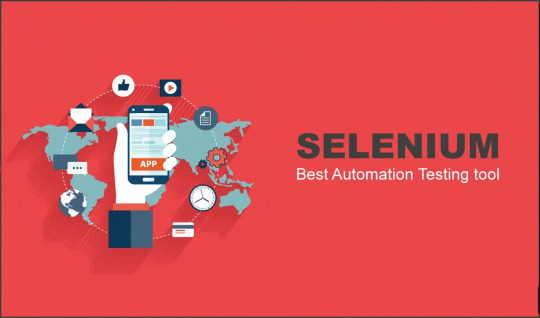#selenium test automation
Text
Maneuvering Selenium Automation Complexities: Refining your Testing Process
Selenium has managed to carve a solid reputation in the terrain of test automation, endowing both developers and testers with the ability to perform extensive web application testing across myriad browsers and operating systems. However, with such extensive capability comes an array of complex challenges. Be it wrangling with constantly evolving web interfaces or ensuring seamless testing flows across various browsers, Selenium's journey is riddled with obstacles. For those striving to triumph over these Selenium inherited hurdles and polish their testing skills, participating in a notable Selenium training program in Pune could be a potential solution. Such programs serve as a rich reservoir of knowledge and qualifications, preparing you to smoothly sail the rough waters of testing, refine your maintenance strategies, and effectively strengthen your test suites' reliability and performance. In this comprehensive guide, let's uncover the common stumbling blocks of Selenium automation and discuss strategies to outsmart them, thereby elevating your testing pursuits.

Bumps on the Road: Test Instability
One common roadblock in the Selenium landscape is the unpredictable aspect of test results. Tests can fail sporadically due to timing disparities, asynchronous page loadings, or varying element identifiers. Managing these inconsistencies can be resource-intensive and may cast a cloud of uncertainty over the reliability of your tests.
Jumping Over Hurdles: Browser Compatibility
The path to flawless test execution across an array of browsers comes with its share of difficulties. Despite Selenium's wide range of browser support, discrepancies in page renditions and interactions can throw off test homogeneity. It requires meticulous planning and execution to ensure consistent test results across different browser environments.
Digging Through the Sand: Web Element Detection
The crux of stable test scripting revolves around the crucial process of identifying web elements. But in the fast-paced world of dynamic web applications, where elements frequently change identities, crafting effective element detectors is anything but an easy task. Strategic approaches need to be established, leveraging unique markers and selector capabilities to secure dynamic element interactions.
Taming the Beast: Asynchronous Operations
The modern web's inclination towards asynchronous JavaScript for real-time content updates often clashes with Selenium's synchronous nature, resulting in potential timing issues. This calls for strategic synchronization methods, incorporating explicit waits to confirm element readiness before proceeding with scripts.

Stepping Up to the Plate: Test Maintenance
Given the ever-evolving nature of web applications, maintaining test scripts becomes a daunting task. This is particularly true for larger Selenium test suites, as they require continual updates to reflect UI or functional changes. Investing in efficient test maintenance practices, including regular code reviews and regression testing, is paramount for ensuring your test suite's sustainability. Consider joining a Selenium Online Training course for in-depth knowledge on test maintenance and assuring your automated testing suite's reliability.
Selenium's Kryptonite: Performance Testing
As much as Selenium excels in functional testing, performance testing such as load tests demands additional tools and frameworks to accurately depict wide-ranging user interactions. The integration of performance testing within your Selenium workflow is crucial for assessing how your system responds and scales under various conditions.
Ensuring Smooth Transitions: Continuous Integration (CI) Strategies
Incorporating Selenium tests into Continuous Integration pipelines calls for careful orchestration to enable efficient test execution and timely feedback. This includes seamless integration with CI tools, effective management of test environments, and clear communication of outcomes, all essential for optimizing your automation processes for continuous delivery goals.
Navigating the Unexpected: Pop-Ups and Alerts
Unexpected browser pop-ups, JavaScript alerts, or dialogs can pose a challenge since Selenium lacks built-in features to handle these. Incorporating robust error-handling strategies within scripts can alleviate this issue, preventing test interference and allowing for graceful failure.
Stretching the Boundaries: Test Scalability
Expanding the scope of Selenium tests to encompass an extensive range of user scenarios and digital environments comes with its own set of challenges. This is particularly true in the context of large, distributed applications. Practices promoting modularization of tests and parallel execution are key to achieving scalability without compromising on testing accuracy.
In conclusion, gaining mastery over Selenium automation calls for a blend of technical knowledge, effective practices, and a solution-focused mindset to overcome common hurdles. Comprehending these obstacles and implementing suitable countermeasures can empower you to enhance your testing proficiency and consistently deliver high-grade software.
#selenium#selenium training#automation#automation testing#selenium test automation#selenium course#programming#qualityassurance#trends
0 notes
Text
Selenium Test Automation Services
OnGraph offers top-tier Selenium Test Automation Services that empower your software testing efforts. Our skilled QA engineers utilize the latest Selenium tools and frameworks to automate your testing processes, ensuring precision and efficiency. With a focus on enhancing test coverage and reducing manual testing efforts, we deliver robust, reliable, and scalable test automation solutions.
0 notes
Text


If you refer Java Revision Notes, you don’t need to install any other apps or web search to prepare the interview questionnaire or examinations.
9 Significant Benefits of Learning Java with Chirag Khimani;
i.) The book is specially prepared for those who want to revise basic concepts before examinations
ii.) Provides Quick and Efficient solutions
iii.) It is color-coded like an elementary book
iv.) This can be handy before the interview so no tedious surfing required
v.) Each topic has purpose and descriptive write-up
vi.) Syntax and example for each concepts that explains clearly
vii.) Books are Pocket Friendly (Cost Effective)
viii.) Overcomes the previous misconceptions which you might had before
ix.) Learning of Java Coding Programs with Chirag is a thrilling experience because he always applies the real world problem to Java puzzles and provides easy solutions which are simple to use
#technology#software#automation#development#selenium#software testing#javaprogramming#java assignment help#developer#code#java interview preperation#java revision notes#java tutorial
2 notes
·
View notes
Text

5 notes
·
View notes
Text
Python Test Reporting: Turning Automation into Insight
Python Test Reporting: Turning Automation into Insight
Have you ever wondered how we can ensure our software runs smoothly every time? That’s where Python for automation testing comes into play. Imagine having a diligent assistant who checks everything for you, never missing a detail. This assistant is your automated test suite, and Automation Testing with Python is the magic wand that brings it to life. Let's dive into how Python helps us create detailed test reports, ensuring we never miss a beat.
Table of Contents
Sr#
Headings
1
Introduction to Python Test Reporting
2
Why Test Reporting Matters
3
Getting Started with Python for Automation Testing
4
Popular Python Testing Frameworks
5
Setting Up Your Testing Environment
6
Writing Your First Test Case
7
Running Tests and Generating Reports
8
Understanding Test Reports
9
Customizing Test Reports
10
Integrating Test Reports with CI/CD
11
Best Practices for Effective Test Reporting
12
Common Challenges and How to Overcome Them
13
Tools to Enhance Your Test Reporting
14
Real-World Examples of Test Reporting
15
Conclusion
Introduction to Python Test Reporting
automation testing in python Reporting is like a detailed report card for your software. It tells you what’s working, what’s not, and where you need to improve. Just as a student relies on report cards to track progress, developers use test reports to understand the health of their codebase.
Why Test Reporting Matters
Test reporting isn't just about finding bugs; it's about providing clear, actionable insights. Without proper reports, fixing issues can be like searching for a needle in a haystack. Test reports summarize your test results, making it easier to identify patterns and recurring issues.
Getting Started with Python for Automation Testing
Before diving into test reporting, let's set the stage with selenium webdriver python. Python’s simplicity and powerful libraries make it a favorite among testers. Here’s how you can get started:
Install Python: Download and install Python from python.org.
Set up a Virtual Environment: This isolates your project dependencies. Use venv:
bash
Copy code
python -m venv myenv
source myenv/bin/activate # On Windows use `myenv\Scripts\activate`
Install Testing Libraries: For this guide, we’ll use pytest and unittest.
Popular Python Testing Frameworks
There are several frameworks available for python automation testing :
pytest: A robust framework that’s simple to use and highly extensible.
unittest: Python’s built-in framework, great for basic test suites.
nose2: An extension of unittest, adding more features and plugins.
Robot Framework: A keyword-driven approach, ideal for non-programmers.
Setting Up Your Testing Environment
Setting up your testing environment correctly is crucial. Here’s a simple setup using pytest:
Install pytest:
bash
Copy code
pip install pytest
Create a Test File: Create a file named test_example.py:
python
Copy code
def test_example():
assert 1 + 1 == 2
Writing Your First Test Case
Writing tests with python selenium tutorial is straightforward. Here’s an example using unittest:
python
Copy code
import unittest
class TestMath(unittest.TestCase):
def test_addition(self):
self.assertEqual(1 + 1, 2)
if __name__ == '__main__':
unittest.main()
Running Tests and Generating Reports
To run your tests and generate a report with pytest, use:
bash
Copy code
pytest --junitxml=report.xml
This command runs your tests and outputs the results in an XML file.
Understanding Test Reports
A test report provides detailed information about each test case, including:
Pass/Fail Status: Indicates whether the test passed or failed.
Error Messages: Provides details on why a test failed.
Execution Time: Shows how long each test took to run.
Customizing Test Reports
You can customize your test reports to include additional information. For example, with pytest, you can use plugins like pytest-html:
bash
Copy code
pip install pytest-html
pytest --html=report.html
This generates a comprehensive HTML report.
Integrating Test Reports with CI/CD
Continuous Integration/Continuous Deployment (CI/CD) ensures your tests run automatically. Integrate test reporting into your CI/CD pipeline to catch issues early:
Jenkins: Use the JUnit plugin to visualize test reports.
GitLab CI: Add the --junitxml=report.xml command to your .gitlab-ci.yml file.
GitHub Actions: Use actions to run tests and upload reports.
Best Practices for Effective Test Reporting
Effective test reporting involves more than just running tests. Here are some best practices:
Regularly Review Reports: Make it a habit to review test reports regularly.
Automate Report Generation: Ensure reports are generated and sent automatically.
Include Relevant Metrics: Customize reports to include metrics that matter to your project.
Common Challenges and How to Overcome Them
Test reporting can be challenging. Here are common issues and solutions:
Large Reports: Use filters to focus on critical tests.
Inconsistent Results: Ensure your tests are deterministic and not flaky.
Integration Issues: Validate your CI/CD pipeline configurations.
Tools to Enhance Your Test Reporting
Several tools can enhance your test reporting experience:
Allure: A flexible, lightweight multi-language test reporting tool.
ReportPortal: Real-time reporting and analytics.
ExtentReports: Beautiful reports with dashboards and charts.
Real-World Examples of Test Reporting
Let’s look at some real-world applications:
E-commerce Sites: Regular test reports ensure that shopping carts and payment gateways work flawlessly.
Banking Applications: Reports help maintain the integrity of transactions and data security.
Healthcare Systems: Testing reports ensure compliance with health standards and patient data safety.
Conclusion
automation python turns repetitive tasks into efficient processes, and test reporting is the window through which we monitor these processes. Detailed, customized reports help us maintain high-quality standards and quickly address any issues. By integrating Automation Testing with Python into your workflow, you can ensure robust and reliable software performance.
FAQs
1. What is Python test reporting?
Automation with Python reporting is the process of documenting the results of automated tests run using Python. It provides insights into the performance and health of your codebase.
2. Why should I use Python for automation testing?
Python is user-friendly, has a rich set of libraries, and is widely supported, making it an excellent choice for automation testing.
3. What are some popular frameworks for Python automation testing?
Popular frameworks include pytest, unittest, nose2, and Robot Framework.
4. How can I generate a test report using pytest?
You can generate a test report by running pytest --junitxml=report.xml for an XML report or pytest --html=report.html for an HTML report.
5. How do I integrate test reports with CI/CD pipelines?
You can integrate test reports with CI/CD pipelines using tools like Jenkins, GitLab CI, and GitHub Actions, which support automated testing and report generation.
0 notes
Text
Stay safe and secure with SafeTest! Ensure your software is reliable and robust with our comprehensive testing solutions.


#automation#testing#automation testing#test automation#automationtesting#efficiency#testautomation#seleniumtesting#selenium#power
1 note
·
View note
Text

Selenium Sparks: Leading Automation Testing in Mohali
Description: Ignite your career with Selenium automation testing in Mohali's premier institute. Gain expertise in Selenium's powerful tools and frameworks through hands-on training led by industry experts. Learn to automate tests, enhance efficiency, and ensure software quality in a dynamic learning environment. Join us and take the next step towards mastering automation testing.
0 notes
Text
Playwright Automation Commands
Discover how Playwright simplifies web automation with easy-to-use commands.here are few common commonds used in playwright.
element.$$(selector): This command helps find all the smaller parts inside a bigger item that match a specific choice.
element.getAttribute(name): With this, we can get information about a certain property of an item.
element.inputValue(): It helps us find out what's typed into an input area.
element.fill(value): This command lets us type something into an input box or a text area.
element.click(): Just like clicking with a mouse, this command mimics pressing on an item.
element.hover(): It simulates moving the mouse over an item without clicking it.
element.selectOption(values): When you have a dropdown menu or a list where you can choose things, this command helps pick the options you want.
page.evaluateHandle(pageFunction[, …args]): This one's a bit more complex. It runs a function on the page and gives back a special kind of result called a JSHandle.
So, Playwright helps automate tasks by letting you do things like finding parts of a webpage, interacting with them (like typing or clicking), and getting information from them.
These commands make it easier to write scripts that can do these tasks automatically.
To learn more about Playwright Training visit Testleaf Page for more about software testing course
0 notes
Text
A Short Digression on Test Data
Lately I've been thinking about test automation and test data. I've come to a rather philosophical opinion.
Test data is always the problem, and test data is never the problem.
Test data is always the problem: Reading posts on generating test data for unit tests but also how to wrangle test data for various environments shows a lot of conflicting thoughts. Some say to never use random test data, some say they love it. Most people agree having "realistic" testing data is helpful but often for security or practical reasons, user data can't be directly imported and used for testing internally. I think in part there's so much conflicting experience because test data is unique to each team working with. Trying to use testing data to test an online banking application is nothing like data needed to test a mobile video game, which are both nothing like needing test data for enterprise accounting software. Throw in the fact that automation and manual approaches also have different needs and you'll see even more confusion.
Test data is unique to every team's problem. Even similar domains or applications may have subtle differences. Teams need to work things out themselves eventually.
Of course there's more to testing than simply data management, which leads to the second part of this, that test data is never the problem.
One of the biggest challenges I've had as a test automation specialist is getting people to understand what test automation is and why it's valuable. Even when I can achieve this and get support, test writing and strategy are still tricky sometimes. Getting developers - and their product managers! - to test and to test well are often bigger problems than whether we have good test data or not. In the words of wonderful Gerald Weinberg, it's always a people problem.
All problems with testing are due to problems of test data, until they aren't.
#ideas#software testing#test automation#quality automation selenium teamwork#thoughts#software#quality
0 notes
Text
Unveiling the Trials of Excelling in Selenium Automation
In the domain of software testing and quality assurance, automation has emerged as a pivotal force, ensuring efficiency, precision, and agility throughout the development cycle. Among the myriad of automation tools at our disposal, Selenium stands as a beacon for web application testing. Nevertheless, mastering Selenium automation presents its own array of hurdles, necessitating unwavering commitment, expertise, and a profound comprehension of both the tool and the underlying technologies. If you aspire to conquer Selenium for automated testing and web scraping, enrolling in a Selenium Course in Pune can furnish you with the indispensable skills to confront its inherent challenges. In this discourse, we embark on an exploration of the intricacies involved in mastering Selenium automation, shedding light on the obstacles encountered by testers and developers along this expedition.

Understanding Selenium:
Before delving into the challenges, let’s first gain a concise understanding of Selenium and elucidate why it garners widespread adoption within the industry. Selenium serves as an open-source tool employed for automating web browsers across diverse platforms. It furnishes a suite of tools and libraries tailored for automating web applications for testing purposes. With its support for multiple programming languages including Java, Python, C#, and more, Selenium offers flexibility and adaptability, catering to a myriad of project requirements.
Challenges Encountered:
Dynamic Element Locators:
A fundamental challenge in Selenium automation pertains to navigating dynamic element locators. Web applications frequently encompass elements whose attributes such as ID, name, or XPath may undergo dynamic alterations upon page reloads or interactions. Devising robust and dependable locators capable of withstanding such alterations necessitates meticulous deliberation and comprehension of the application’s structure and behavior.
Synchronization Issues:
Synchronization dilemmas arise when the automation script executes actions at a pace exceeding the responsiveness of the web application, resulting in erratic and unreliable test outcomes. Exercising patience for elements to become visible, clickable, or for specific events to transpire is imperative for synchronizing automation scripts with the application’s behavior. Implementing efficacious synchronization strategies such as implicit and explicit waits is imperative for mitigating these issues.
Cross-Browser Compatibility:
Ensuring the compatibility and consistency of web applications across different browsers and versions is paramount. However, each browser may interpret and render web elements disparately, engendering disparities in test results. Mastering Selenium automation entails crafting scripts that are robust and adaptable enough to seamlessly execute across multiple browsers, warranting thorough testing and debugging.

Handling Asynchronous Behavior:
Modern web applications heavily rely on asynchronous JavaScript to augment interactivity and responsiveness. Grappling with asynchronous behavior poses a significant challenge for Selenium testers as it mandates waiting for AJAX requests, animations, or dynamic content to load before executing actions or assertions. Employing techniques such as polling, explicit waits, or leveraging Selenium’s built-in features like WebDriverWait is imperative for effectively managing asynchronous behavior.
Maintenance of Test Suites:
As applications evolve and undergo alterations, maintaining and updating existing test suites becomes an arduous endeavor. Test scripts may succumb to breakages owing to UI modifications, functionality enhancements, or code refactoring, necessitating vigilant monitoring and upkeep. Embracing a modular and maintainable test architecture, implementing version control, and periodically reviewing and refining test code are indispensable practices for ensuring the durability and sustainability of Selenium test suites.
Limited Support for Non-Web Elements:
While Selenium excels in automating web-based interactions, its efficacy diminishes when tasked with automating non-web elements such as desktop applications, mobile apps, or APIs. Integrating Selenium with other tools or frameworks such as Appium for mobile automation or REST-assured for API testing may be imperative for attaining end-to-end test coverage within intricate software ecosystems.
Test Data Management:
Effective management of test data is pivotal for executing comprehensive test scenarios and ensuring adequate coverage. However, generating and maintaining test data sets, particularly for large-scale applications, can prove to be a formidable challenge. Test data may necessitate randomization, parameterization, or extraction from external databases, warranting sophisticated data management strategies and frameworks to streamline the testing process.
Overcoming the Challenges:
Mastering Selenium automation is undeniably an uphill journey, yet with the right approach and resources, these challenges can be surmounted:
Continuous Learning and Skill Development: Remaining abreast of the latest advancements in Selenium and associated technologies through Selenium Online Course, tutorials, and community forums is imperative for augmenting proficiency and staying ahead in the field.
Collaboration and Knowledge Sharing: Engaging with peers, participating in online communities, and attending industry conferences foster knowledge sharing and impart valuable insights into best practices and emerging trends in Selenium automation.
Robust Test Design and Architecture: Devoting time to designing scalable, maintainable, and reusable test frameworks tailored to the specific needs of the project minimizes maintenance overhead and amplifies the reliability and efficiency of automation scripts.
Comprehensive Testing Strategy: Integrating Selenium automation with other testing approaches such as unit testing, API testing, and performance testing facilitates comprehensive test coverage, enabling the identification of defects early in the development lifecycle and ensuring the overall quality of the software product.
Automation Infrastructure Setup: Establishing a robust automation infrastructure encompassing CI/CD pipelines, version control systems, and test management tools streamlines the execution and management of automated tests, fostering collaboration and efficiency within the development team.
Conclusion:
Mastering Selenium automation epitomizes a voyage that demands resilience, dedication, and a readiness to confront challenges and glean insights from setbacks. By comprehending the nuances of Selenium, embracing best practices, and harnessing the abundant resources available within the testing community, testers and developers can transcend obstacles and harness the full potential of automation to deliver high-quality software products that resonate with the exigencies of today’s dynamic and competitive market landscape.
#selenium#selenium training#automation#automation testing#selenium test automation#selenium course#programming#qualityassurance#trends
0 notes
Link
Looking for testing your web, welcome at OnGraph Technologies, we offer Selenium Test Automation Services at the best affordable prices. Selenium is an open-source automation testing service that's suite for web applications across different browsers and platforms. To know more about us and our services browse online ongraph.com.
0 notes
Text
Become a Testing Hero: Your Beginner's Guide to Conquering Selenium Test Cases
Automate like a pro! This guide equips you with the key steps to write your first Selenium test case and become a master of web application testing.
Stop tedious manual testing! Learn how to automate repetitive tasks and free up your time for more strategic coding challenges.
Test Case 1 : How to verify Internal and External Links of any WebPage.
Read More
0 notes
Text
Software testing services company in India
We ensure the reliability, functionality, and performance of your software products by employing best practices in the industry and state-of-the-art tools. We have included some services such as functional testing, regression testing, performance testing, and security testing in our set of comprehensive testing services that help businesses decrease their risks and ensure flawless software delivery. We are working to fulfill your need, with test strategies that match requirements, drawing on our broad experience in other domains such as fintech, healthcare, and e-commerce. Get in touch with Binary Informatics to source reliable software testing services and improve your product quality.
0 notes
Text
Python for Regression Testing: Streamlining Your Automation Efforts

Python for Regression Testing: Streamlining Your Automation Efforts
Introduction
In today's fast-paced digital world, ensuring the quality of software products is paramount. With the ever-increasing complexity of applications, manual testing alone is not sufficient to catch all the bugs and errors. This is where automation testing comes into play, and Automation with Python emerges as a powerful tool for regression testing. But what exactly is regression testing, and how does Python facilitate it? Let's embark on a journey to explore the synergy between python for automation testing and regression testing.
Table of Contents
Sr#
Headings
1.
Understanding Regression Testing
2.
The Need for Automation in Testing
3.
Introduction to Python
4.
Python for Automation Testing
5.
Benefits of Using Python for Regression Testing
6.
Setting Up Your Regression Testing Environment
7.
Writing Regression Tests with Python
8.
Executing Regression Tests
9.
Analyzing Test Results
10.
Integrating Python with Testing Frameworks
11.
Best Practices for Python Regression Testing
12.
Challenges and Solutions
13.
Future Trends in Python Regression Testing
14.
Conclusion
1. Understanding Regression Testing
Regression testing ensures that recent code changes haven't adversely affected existing functionalities. It involves re-running previously executed test cases to verify that new code modifications haven't introduced any unintended side effects.
2. The Need for Automation in Testing
Manual testing is time-consuming, repetitive, and prone to human error. Automation offers a solution by enabling the execution of tests quickly and efficiently, freeing up valuable time for testers to focus on more complex scenarios.
3. Introduction to Python
python selenium tutorial is a versatile and beginner-friendly programming language renowned for its simplicity and readability. Its extensive libraries and frameworks make it an ideal choice for various applications, including automation testing.
4. Python for Automation Testing
python automation testing simplicity and flexibility make it a perfect fit for automation testing. Its syntax resembles pseudo-code, making it easy to write and understand test scripts even for non-programmers.
5. Benefits of Using Python for Regression Testing
Ease of Learning: Python's simple syntax and extensive documentation make it easy for testers to grasp and utilize.
Versatility: Python offers a wide range of libraries and frameworks tailored specifically for testing purposes, enhancing productivity and efficiency.
Integration Capabilities: Python seamlessly integrates with existing tools and frameworks, allowing for smooth collaboration within development teams.
6. Setting Up Your Regression Testing Environment
Before diving into regression testing with Python, it's essential to set up your development environment. Install Python and relevant testing frameworks like PyTest or unittest to get started.
7. Writing Regression Tests with Python
Python enables testers to write concise and expressive test scripts. Leveraging libraries like Selenium for web testing or Appium for mobile testing, testers can automate interactions with applications effortlessly.
8. Executing Regression Tests
Once the test scripts are written, executing them is a breeze with Python. Utilize automation tools or IDEs like PyCharm to run tests and monitor their progress.
9. Analyzing Test Results
Automation Testing with Python provides robust mechanisms for analyzing test results. Utilize reporting libraries like HTMLTestRunner to generate comprehensive test reports, aiding in identifying and resolving issues efficiently.
10. Integrating Python with Testing Frameworks
automation testing in python seamlessly integrates with popular testing frameworks like Jenkins or Travis CI, enabling continuous integration and deployment pipelines for seamless testing and development workflows.
11. Best Practices for Python Regression Testing
Modularization: Break down test scripts into smaller, reusable modules for better maintainability and scalability.
Parameterization: Utilize parameterization techniques to run tests with different input data, increasing test coverage.
Version Control: Use version control systems like Git to track changes in test scripts and collaborate effectively within teams.
12. Challenges and Solutions
While Python simplifies regression testing, challenges such as cross-browser compatibility or dynamic UI elements may arise. Address these challenges by leveraging appropriate libraries and adopting robust testing strategies.
13. Future Trends in Python Regression Testing
As technology evolves, so does the landscape of regression testing. Expect to see advancements in AI-driven testing, containerization, and test automation orchestration with Python leading the charge.
14. Conclusion
python in automation testing revolutionizes regression testing by offering a powerful yet simple toolset for automation. Its versatility, ease of use, and integration capabilities make it the go-to choice for testers looking to streamline their testing efforts and ensure the quality of software products.
FAQs
1. Can Python be used for automating regression tests?
Yes, Python is well-suited for automating regression tests due to its simplicity, versatility, and extensive libraries tailored for testing purposes.
2. What are some popular testing frameworks that integrate with Python?
Popular testing frameworks that integrate seamlessly with Python include PyTest, unittest, Selenium, and Appium.
3. How can I set up my regression testing environment with Python?
Setting up a regression testing environment with Python involves installing Python and relevant testing frameworks like PyTest or unittest, then writing and executing test scripts using automation tools or IDEs like PyCharm.
4. What are the benefits of using Python for regression testing?
Some benefits of using Python for regression testing include ease of learning, versatility, integration capabilities, and extensive libraries and frameworks tailored for testing purposes.
5. Are there any best practices for writing regression tests with Python?
Yes, some best practices for writing regression tests with Python include modularization, parameterization, version control, and adopting robust testing strategies to address challenges effectively.
0 notes
Text

Streamline your testing process with the unmatched expertise of Playwright Consulting Excellence! https://www.automationqa.co/top-playwright-testing-consultants/
#testing#automation#automation testing#test automation#selenium#testautomation#automationtesting#seleniumtesting#efficiency#power
1 note
·
View note
Text

Best Automation testing tool is SELENIUM
0 notes